PETALING JAYA: Malaysia’s economy is projected to slow in 2025 due to mounting external headwinds, despite a temporary surge in exports early in the year.
Resilient demand for electrical and electronics (E&E) products and a recovering tourism sector are expected to buffer economic growth, with Bank Negara Malaysia (BNM) set to proactively support domestic demand through monetary easing amid low inflation.
The ICAEW Southeast Asia Economic Insight: Q2’25 report, forecasts Malaysia’s GDP growth will moderate to 4.3% in 2025, down from 5.1% in 2024.
This slowdown reflects broader global economic uncertainties, particularly stemming from trade tensions and weaker demand from key trading partners, including the US and China.
Malaysia’s goods exports surged by 26% year-on-year in April 2025, driven by businesses front-loading shipments to the US to avoid impending tariff hikes. However, this is expected to be a temporary boost, with export growth likely to moderate significantly in the second half of the year.
The report notes that goods export growth had already slowed notably to 1.6% year-on-year in Q1’25, well below the 7.1% average growth rate recorded over the preceding three quarters.
Despite Malaysia’s diversified export base, it remains vulnerable to external shocks, with more than 4% of its GDP and approximately 11% of its gross exports tied to US demand, either directly or indirectly, further underscoring the country’s vulnerability to external shocks.
A blanket US tariff rate of 10% on Malaysian imports, although lower than the initially proposed 24% rate, still poses substantial downside risks for exporters. Additionally, weaker demand from China, Malaysia’s largest export destination, creates further threats to Malaysia’s external trade environment.
Resilient global demand for electronics, crucial as intermediate goods in global supply chains continues to support Malaysia’s E&E exports, which have grown by approximately 20% year-to-date. This robust performance is crucial, given Malaysia’s key role in the global semiconductor supply chain.
Securities Commission Malaysia executive chairman and ICAEW council member Datuk Mohammad Faiz Azmi recently noted that Asean’s strength lies in its unity and shared purpose.
In a time of global uncertainty, he had said working together and investing within the bloc will be key to unlocking the region’s potential.
He made the statement during the Asean Investment Conference 2025, held in Kuala Lumpur, where he also emphasised the importance of deepening regional cooperation to ensure resilience against global shocks.
Tourism, particularly driven by Asean visitors who accounted for 67% of total tourist arrivals in 2024, remains another critical buffer for economic growth. While tourism-related services exports grew robustly by 17% year-on-year in Q1’25, future visitor arrivals may face headwinds from employment and income uncertainties in key source countries.
With elevated public debt constraining fiscal expansion, monetary policy is anticipated to play a pivotal role in supporting the domestic economy. Inflation has remained subdued at around 1.5%, creating room for BNM to introduce a 50 basis-point rate cut later in 2025. The central bank has already signalled an accommodative stance, aiming to mitigate risks stemming from subdued domestic investment and consumer spending.
The ICAEW report also highlights economic indicators from March 2022 to March 2025, noting a clear deceleration trend in Malaysia’s GDP growth, private consumption, and goods and services exports – emphasising the broader economic slowdown driven by external uncertainties and cautious domestic sentiment.
Despite the turbulence, Malaysia’s economy is expected to stay on course, supported by resilient key sectors and timely policy action.









